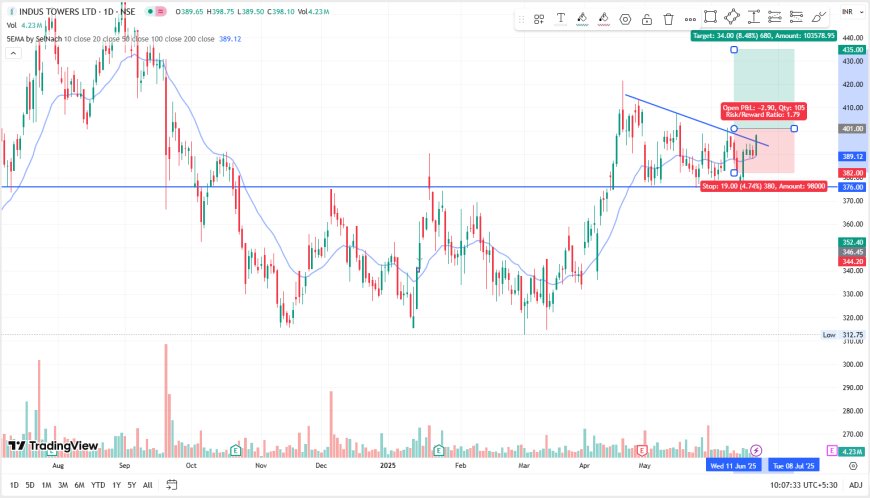INDUSTOWER CMP 396. BUY ABOVE 401 TARGET 412-435, SL BELOW 382.

INDUSTOWER CMP 396. BUY ABOVE 401 TARGET 412-435, SL BELOW 382.
The stock was in a consolidation phase with a descending channel (wedge) formation. The stock could be on the verge of upside breakout if it closes above Rs.401 and expected target could be Rs.435 or higher. The risk could start if closes below the price level of Rs.375. Risk and reward is favorable for the positional trader.
Looking at broader performance metrics, Indus Towers has shown resilience over the past year, with a gain of 12.14%, slightly outperforming the Sensex's 11.09%. Over three years, the stock has surged by 99.48%, significantly exceeding the Sensex's 55.73% increase. However, over the last five years, Indus Towers has lagged behind the Sensex, which has risen by 172.26%.
Global brokerage firm Citi has reiterated its bullish stance on Indus Towers, maintaining a 'buy' rating and a target price of Rs 490 suggesting 25% upside potential.
Indus Towers benefits from the govt's move to convert Vodafone Idea's debt into equity, boosting cash flow and growth prospects. Indus could capture 66% of Vi's network expansion between FY25-FY28.
The central government’s decision to convert part of Vodafone Idea’s spectrum debt into equity will not only give the cash-strapped telco some much needed cash flow relief, but will also translate to improved growth prospects for Indus Towers, analysts said.
The tower company, which counts Vodafone Idea as one of its major customers, and will now benefit from the telco’s accelerated network expansion, and will have better visibility on repayment of dues by Vodafone Idea.
This (the debt-to-equity conversion in Vodafone Idea) is positive for Indus in the medium term, unless Vi’s RMS (revenue market share) falls meaningfully below its current ~15% warranting a reduction in equipment intensity.
Company Profile :
Indus Towers Limited is one of India’s leading telecommunications infrastructure companies, playing a crucial role in enabling digital connectivity across the nation. As the backbone of India’s mobile communication ecosystem, Indus Towers provides passive infrastructure support—including tower sites, power management, and maintenance services—to telecom operators, ensuring seamless network availability and scalability.
Formed in 2007 as a joint venture among Bharti Infratel, Vodafone India, and Aditya Birla Group’s Idea Cellular, Indus Towers underwent a significant structural transformation in 2020 when it merged with Bharti Infratel. Today, it operates as a listed public company under the ticker INDUSTOWER on Indian stock exchanges.
Business Model and Core Offerings
Indus Towers operates an asset-light and high-margin business model, leasing out telecom tower infrastructure to mobile network operators (MNOs). Its core services include:
· Tower installation and co-location for network providers
· Operation and maintenance of telecom sites
· Energy and power solutions for uninterrupted tower functioning
· Smart city and fiber-ready infrastructure in select urban zones
As of FY25, Indus Towers manages over 200,000 towers across 22 telecom circles, making it one of the largest tower infrastructure providers in the world.
Client Base and Strategic Partnerships
The company’s major clients include India’s leading telecom operators:
· Bharti Airtel
· Vodafone Idea
· Reliance Jio (in select cases through agreements)
Bharti Airtel holds a controlling stake in Indus Towers, and the synergy between the two enables infrastructure sharing, cost efficiencies, and rapid 5G rollout plans.
Indus also maintains long-term Master Service Agreements (MSAs) with its clients, ensuring predictable revenue streams and robust cash flow.
Technology & Growth Drivers
With India’s growing data demand and government push for 5G and rural broadband, Indus Towers is in a strong position to benefit from:
· 5G Network Expansion: Significant tower densification will be required for low-latency coverage
· Digital India Initiatives: Supporting infrastructure for BharatNet and smart cities
· IoT and Edge Computing: Passive infrastructure required for emerging tech applications
· Energy Management: Focus on renewable energy and energy-efficient towers to reduce costs and carbon footprint.
Indus Towers has committed to a sustainability roadmap that includes:
· Reducing diesel usage and transitioning to solar power
· Improving energy efficiency per tower
· Adopting eco-friendly infrastructure designs
The company publishes an annual ESG Report and actively monitors its carbon emissions, aiming to be among the greenest telecom infra firms in Asia.
Indus Towers stands at the forefront of India's digital transformation journey. As the demand for faster, more reliable mobile networks grows—driven by 5G, IoT, and rural connectivity—Indus’s infrastructure network forms the foundation of this new digital era. With a solid financial base, strategic industry relationships, and a forward-looking sustainability plan, Indus Towers is well-positioned for long-term value creation.
What's Your Reaction?
 Like
0
Like
0
 Dislike
0
Dislike
0
 Love
0
Love
0
 Funny
0
Funny
0
 Angry
0
Angry
0
 Sad
0
Sad
0
 Wow
0
Wow
0












































































